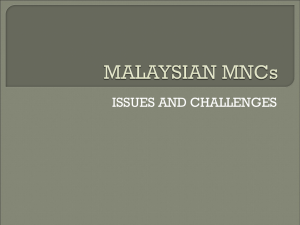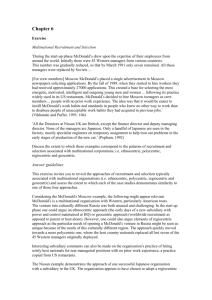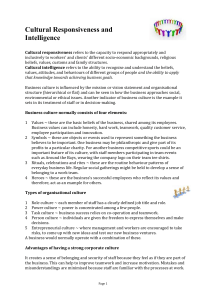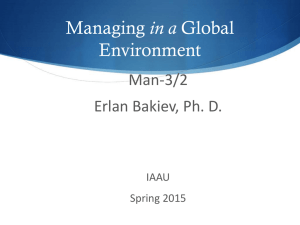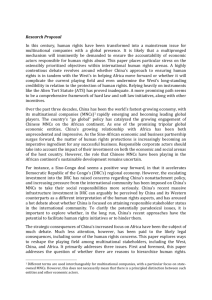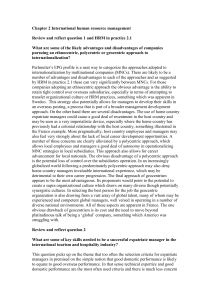Multinational corporation management strategies and
advertisement
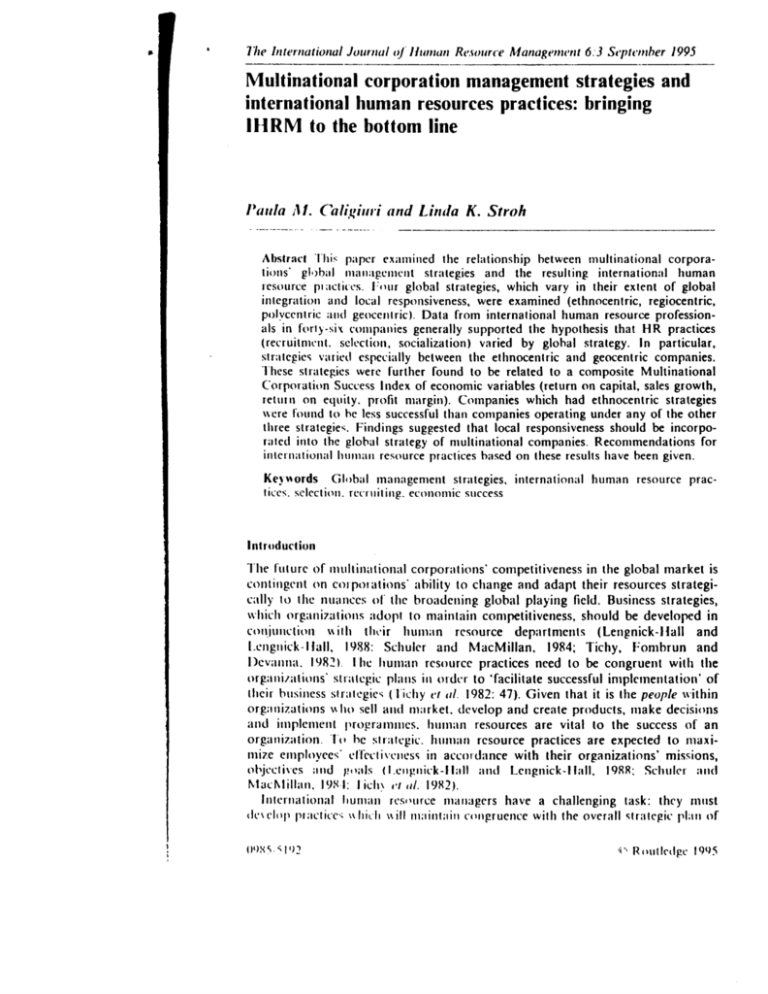
r<
The International Journal of Human Resource Management 6 :3 September 1995
Multinational corporation management strategies and
international human resources practices : bringing
1 H R M to the bottom line
Paula i11 .
Abstract
(ali,t'iiiri and Linda K . Stroh
This
paper examined the relationship between multinational corpora-
tions' global management strategies and the resulting international human
resource piactices . Four global strategies, which vary in their extent of global
integration and local responsiveness, were examined (ethnocentric, regiocentric,
polycentric and geocentric) . Data from international human resource professionals in forty-sir companies generally supported the hypothesis that HR practices
(recruitment . selection, socialization) varied by global strategy . In particular,
strategies varied especially between the ethnocentric and geocentric companies .
These strategies were further found to be related to a composite Multinational
Corporation Success Index of economic variables (return on capital, sales growth,
return on equity . profit margin) . Companies which had ethnocentric strategies
were found to be less successful than companies operating under any of the other
three strategies . Findings suggested that local responsiveness should be incorporated into the global strategy of multinational companies . Recommendations for
international human resource practices based on these results have been given .
Keyssords Global management strategies, international human resource
tice . selection . recruiting . economic success
prac-
Introduction
The future of multinational corporations' competitiveness in the global market is
contingent on cot potations ability to change and adapt their resources strategically to the nuances of the broadening global playing field . Business strategies,
which organizations adopt to maintain competitiveness, should be developed in
conjunction ssillt their human resource departments (Lengnick-Hall and
Lengnick-Hall, 1988 : Schuler and MacMillan . 1984 ; Tichy, Fombrun and
1)cvanna . 1982) . I he human resource practices need to be congruent with the
organizations' strategic plans in order to 'facilitate successful implementation' of
their business strategies (l ichy et al. 1982 : 47) . Given that it is the people within
organizations ssho sell and market, develop and create products, make decisions
and implement programmes, human resources are vital to the success of an
organization . To be strategic . human resource practices are expected to maximize employees effectiveness in accordance with their organizations' missions,
objectives and goals (Lengnick-llall and Lengnick-Ilall, 198R : Schuler and
MacMillan, 1981 : I ichs et
ail .
1982) .
International human resource managers have a challenging task : they must
(]e\ clop practice : Mticli still main( ;iin congruence with the overall strategic plan of
09X5-x192
Routlcdge 1995
Multinational corporate management and international FIR practices 495
their respective multinational corporations (MNCs), while balancing the economic, social, political and legal constraints of the various host countries
(Milliman, Von Glinow and Nathan, 1991) . This paper addresses : (I) the various
international management strategies proposed in the theoretical literature, (2) the
HR practices associated with these international management strategies and (3)
the ultimate effect the strategies have on the bottom line effectiveness of MNCs .
Global business strategies : global integration and local responsiveness
Global management strategies in multinational companies will vary greatly . The
processes, practices, systems and structures developed to implement those strategies will likewise vary . Developing global strategies can be difficult, given the
conflicting demands the global environment places on MNCs . The conflicting
demands often arise as MNCs attempt to maximize their abilities to respond to
the needs of the host countries (local responsiveness), while trying to maintain
their controlled corporate structure worldwide (global integration) . Oftentimes,
the more autonomy foreign subsidiaries have to act independently and respond
to local demands, the less integrated the worldwide organization becomes - and
vice versa (Prahalad and Doz, 1987 ; Tung and Punnett, 1993).
Not much has changed since the 1970s when Heenan and Perlmutter (1979)
did their original work on classifying MNCs' management strategies (Adler and
Ghadar, 1990) . More recently, however, these strategies have been reconceptualized in terms of the MNC life cycle - consistent with the product generation and
sales phases of developing MNCs (Adler and Ghadar, 1990 : Milliman, Von
Glinow and Nathan, 1991) . Using either the life-cycle model or classification
model, the resulting management strategies involve the interplay between global
integration and local responsiveness . In Heenan and Perlmutter's (1979) language, four such management strategies are : (I) ethnocentric, (2) polycentric, (3)
regiocentric and (4) geocentric . In general, these correspond to the (1) Domestic
(Phase 1), (2 3) International and Multinational (Phases 2 and 3), and (4)
Global (Phase 4), phases in the MNC life-cycle literature (for a thorough review
of the theory of MNC life cycles in HRM, see Adler and Ghadar, 1990, and
Milliman et a!., 1991). The tleenan and Perlmutter labels (ethnocentric, polycentric, regiocentric and geocentric) will be used for this paper .
In general, the ethnocentric strategy suggests that companies should maximize
their parent company control in order to integrate subsidiaries, at the cost of
local responsiveness. The polycentric and regiocentric approaches both allow for
more local responsiveness -- with less corporate integration . The geocentric strategy is the 'ideal', as it attempts to balance both global integration and local
responsiveness . In a hierarchy, the geocentric strategy would be the best because
it incorporates both of the theoretical ideals . Polycentric and regiocentric strategies would be second because they satisfy the local responsiveness ideal (usually
at the cost of global integration) . Ethnocentric strategies, focusing on headquarters' control, are neither globally integrated nor locally responsive .
Generally, as foreign subsidiaries mature, they become more resource independent 'with respect to strategic resources, such as technology, capital, management, access to markets' (Prahalad and Doz . 1481 : 5) . With the dependency on
the parent organization gone, multinationals, who wish to maintain control
over their otherwise autonomous subsidiaries, use alternative methods such as
496
Paula M . Caligiuri and Linda K. Stroh
fostering the parent organization's corporate culture worldwide (Prahalad and
Doz, 1981) . The extent to which MNCs desire their worldwide employees to
share their corporate cultures will determine how (and if) host nationals are
socialized into the parent corporate culture (Wilkins and Ouchi, 1983) . This will
be evidenced through the processes and resource allocation given to socialization
methods such as sending expatriates abroad to propagate corporate culture,
selecting individuals who share the organization's values, bringing host nationals
in house `to learn hog+ things are done', etc . (Kobrin, 1988 ; Doz and Prahalad,
1981) .
Various human resource management practices are contingent upon the
MNCs' international management strategy (Adler and Ghadar, 1990 : Heenan
and Perlmutter, 1979 ; Kobrin, 1988 ; Milliman et al., 1991 ; Tung, 1982 ; Tung
and Punnett, 1993) . The staffing policies which MNCs adopt for their foreign
subsidiaries (e .g ., recruitment, selection and placement), and the socialization
tactics used for host national employees are examples of practices which will
vary according to the strategy chosen . For example, when staffing a foreign subsidiary, several MNCs appoint expatriate employees to fill a variety of key positions abroad (Kobrin, 1988 ; Stroh, Dennis and Cramer, in press ; Tung, 1981).
When positions in foreign subsidiaries are not staffed by expatriates, they are
staffed by either third-country nationals or host nationals . There are benefits
associated with host nationals staffing MNCs' subsidiaries . Host nationals are
familiar with their own countries' cultures, languages, values, laws and
resources, which makes the job of running the subsidiaries easier . In addition,
unlike expatriates, there are no relocation costs associated with host nationals .
Despite the benefits of host nationals, given their business strategy, many ethnocentric MNCs arc unwilling to give up the bureaucratic control over foreign
subsidiaries, and prefer to place expatriates in (at the very least) their key positions abroad (Tung, 1982 ; Ondrack, 1985) . This paper provides construct validation for the Heenan and Perlmutter classifications (ethnocentric, polycentric,
regiocentric and geocentric) from a human resources perspective . We will
describe, and then empirically demonstrate, which HR practices are consistent
with Ilecuan and I'crlmutter's global management strategies .
Ethnocentric IFIRM1 practices Staffing subsidiaries with expatriates in key management positions will centralize the parent-company control in decision making
more than when subsidiaries are managed by host-country nationals (Egelhoff,
1988 ; Kobrin, 1989) . 1 his ethnocentric management practice is common in startup ventures and when rare technical skills are needed which cannot be found in
the local labour force ('lung and Punnett, 1993) . IIIRM is responsible for
finding suitable expatriates who will be successful abroad . The current literature
suggests there is an extraordinarily high turnover rate among expatriates, and
that success in the expatriate situation takes a special set of skills and abilities
above and beyond the necessary technical skills for the analogous domestic position (Tung . 1982) . Financial (i .e . . expatriates are quite expensive) and legal limitations li .e, foreign employment laws) often interfere with companies operating
from this strategy .
Ethnocentric multinational corporations expect their expatriate managers to
transfer headquarters' cultures and philosophy by working with host nationals
Wdstront and ( ; ;ilhr ;iiili . 1977 : 1~pelhoff, 1988 ; Ti rhiorn, 1985) . IIowevcr . given
Multinational corporate management and international FIR practices
497
the nature of the socialization process, the expatriates, who are sent to socialize
the host nationals to their parent corporate cultures, are often being socialized
themselves by the host nationals (Lee and Larwood, 1983) . The reason for this
is that the value structure of the host nationals is not being directly influenced
by the parent company . Some data show that subsidiaries, even when managed
by expatriates, will have corporate cultures more consistent with their own
countries' cultures than with that of the parent company (Lee and Larwood,
1983) .
Polycentric and regiocentric IHRM practices In a polycentric MNC host
nationals manage subsidiaries with some co-ordination from headquarters on
how the subsidiary should operate . For these organizations, host-national
employees manage the foreign subsidiaries, and expatriates are rarely (if' ever)
used . Host nationals have no language and culture barriers, and are less costly
than expatriates . However, parent-company employees are unable to gain the
valuable global perspective from working abroad . Likewise, host nationals are
not socialized to the parent companies' organizational culture through either
contact with host nationals or transfers into the parent country . Host nationals
are able to develop as managers in their own country, but their own careers will
be limited because they are never able to reach the corporate level . In polycentric organizations, there is little concern for a common corporate culture
(Heenan and Perlmutter, 1979) .
A management strategy similar to polycentric is regiocentric . From this perspective, host-country nationals and third-country nationals are recruited,
selected and developed on a regional basis . Regions are consistent with some
natural boundary, such as the European Economic Community or the Middle
East . In regiocentric MNCs, the communication and integration systems must
be highly sophisticated for headquarters to maintain control over the regions .
As in the polycentric perspective, the likelihood of host nationals' career
advancement is greatest within the region, but still may be limited in headquarters . As in the polycentric perspective too, however, the host nationals are given
the opportunity to manage their own subsidiaries .
Geocentric 1HRM practices When MNCs desire an integration of all of their
foreign subsidiaries and the melding of a worldwide corporate culture, they
adopt a geocentric management strategy (Heenan and Perlmutter, 1979) . MNCs
adopting this strategy will staff positions worldwide such that the best people
are recruited for positions, regardless of nationality (Heenan and Perlmutter,
1979 ; Kobrin, 1988) . Since headquarters and the foreign subsidiaries of any geocentric MNC will view themselves as integrated parts of a global organization,
the corporate culture will be highly unified - but not necessarily dictated by
headquarters . The geocentric organization has the most complex organizational
structure, requiring the greatest aiiiount of communication and integration
across national boundaries (Edstrom and Galbraith, 1977) .
In geocentric MNCs, socialization of the organizations' values is used as a
control strategy with the greatest amount of flexibility to accommodate the
differences among foreign countries' cultures (Edstrom and Galbraith,
1977) . Employees in the foreign subsidiaries learn and internalize the values,
behaviours, norms, etc . . of the rlohul company . They do so through contacts
498
Paula A! . Caligiuri and Linda K. Stre!:
with the parent company and the other foreign subsidiaries, transfers and visits
to various foreign locations (e .g ., parent-company employees transferring abroad
to develop global orientations), training from both the parent company and the
subsidiaries, etc . This strategy 'permits the greatest amount of local discretion
and the greatest amount of decentralization while maintaining overall integration' (Edstrom and Galbraith . 1977 : 251) . MNCs adopt strategic socialization
processes so that their employees will have increased knowledge of the MNCs'
entire networks, and not just the networks within their own countries' subsidiaries Il3ird and hlukada . 1989) . 'The intent is to deemphasizc national cultures and to replace them with an integrating corporate culture' (hds(roni and
Galbraith, 1977 : 256) .
The above noted literature review provides a framework for examining the
construct validation of Ileenan and Perlmutter's work on international management strategies . Consistent with the construct validation framework, these first
two sets of research questions were developed .
l . Ellrnucerrtric AMA'C :v intend to maintain the parent (i.e ., headquarters') cornpan, culture through all oftheir . foreign subsidiaries more than regiocentric, polycertric and geocentric . Likewise, geocentric companies are less concerned with
maintaining the parent culture than regiocentric . polycentric or ethnocentric .
2 . Ethnocentric, polycentrie, regiocentric and geocentric AINCs have IIR practices r on.c i.stent it itl: their global management strategies .
2a. Ethnocentric companies gill recruit glohallr' less than per!}'centric •• regiocentric or geocentric MNCc . Geocentric AINCc Will practise global recruitment
rno .ct of all three groups .
2h . Ethnocentric companies will maintain their selection standards worldwide
less than polycentric, regiocentric and geocentric AMNC's . Geocentric AINCs will
maintain their' selection standards most of all three groups .
2c. Ethnocentric companies it-ill socialize their host nationals br • teaching then :
the parent company's watt • of doing things more than polycentric, regiocentric
and geocentric AMNCc . Geocentric, polr'ce» tric • and regiocentric will he the same
on their use o/ perrcm connpartt' .Sotiali_etion practices .
Strategic international 1l Rr11 and overall econonlic Success
From a human resources perspective, geocentric MNCs have an increased talent
pool front which to draw, given that they will recruit and select the best from
their worldwide talent to fill key positions (that is, within legal restrictions) . This
approach to human resources is more strategic, and will give these geocentric
MNCs a competitive advantage . In addition, these employees will gain global
perspectives and international skills which will further strengthen the MNC's
competitive edge (Edstrom and Galbraith, 1977 ; Kobrin, 1988 ; Tung and Miller,
1990) . Our final hypothesis relates the MNCs' management strategy to the bottonm-line effectiveness of the organization .
3 . Geocentric . iegroccniric and polycentrie AINCc trill show more proltahility
and growth in then rc~t~retit c rnholtic%t than AINCs ii-ho manage Iron : an ctlmo(entrie perspee tire .
Despite the titan' henclit, of ntanaeing from a geocentric strategic perspective .
Multinational corporate management and international FIR practices 499
companies may have legal, political or cultural constraints, given the foreign
context, which may prevent them from operating geocentrically (Tung and
Punnett, 1993) . It is the responsibility of international human resources groups
to develop practices which are consistent with the legal, political and cultural
restrictions of the host countries . Involving human resources during both the
formulation and the implementation of the strategic plan will enable IHRM to
provide recommendations for operating effectively in a global context .
Method
Sample and procedure
Questionnaires were sent to the forty companies represented in the International
Interest Group of the Human Resource Management Association of Chicago
(I-IRMAC) . The items for this study (see Appendix A) were a part of a larger
survey conducted by the second author, in association with HRMAC . Included
in the mailing was a self-addressed (to the second author), stamped envelope . A
total of twenty-eight responses were received after one follow-up phone call,
resulting in a response rate of 70 per cent . Questionnaires were also sent to the
general membership of HRMAC . Members whose organizations were involved
in staffing foreign subsidiaries (e .g., had expatriates in their organizations) were
asked to fill out the questionnaire and return it in the self-addressed, stamped
envelope . Twenty-three members responded, resulting in a sample of fifty-one
human resource specialists for the study (28 = International Interest Group ; 23
= general IIRMAC membership) .
Sixty-six per cent of the human resource specialists in the sample were male ;
their average age was 40 years old, and 93 per cent worked in middle/upper
human resource management. Of the fifty-one respondents, five respondents had
to be dropped from the sample due to incomplete data or data which were not
interpretable . Surveys from the remaining forty-six respondents, representing
forty-six MNCs, were used in all subsequent analyses .
The forty-six multinational companies in this sample came from a variety of
industries : business services and supplies, capital goods, chemicals, computer
and communications, construction, consumer durables, energy, financial services,
food, drink and tobacco, and health . Of the forty-six multinational companies
represented, we were able to collect profitability and growth information for
twenty companies (i .e . . 43 per cent of the company sample) .
Aeasures
The measured variables included in this study are described below . The HR
Practices (Measures 1-4) were developed using principal components analysis
(described in the results section) . See Appendix A for the actual scale items .
I Desire for a unified corporate culture for this measure, we asked respondents
to indicate the extent to which their organizations desired to maintain their
headquarters' corporate culture in their foreign subsidiaries . Two items, each
measured on live-point scales (5- strongly agree to I= strongly disagree) were
added and then averaged (At - 2.72 . SD = .76) . The correlation between the
t%%o items was significant (r = .31 . p
.05) . The items were coded such that a
500
Paula M . C'aligiuri and Linda K . Strolr
high score indicated more tolerance for the immersion of local cultures, whereas
low scores reflected a desire for conformity among all foreign subsidiaries with
the parent organization .
2 Hill practice : recruitment Four items were generated to identify the recruitment practices of multinational companies . The items were measured on a fivepoint scale (5 = strongly agree to I = strongly disagree) added, and then
averaged . The scale had an overall alpha coefficient of .73 (M = 2 .83 . SD= .77) .
High scores on this scale indicate that MNCs' recruitment practices are global
(e .g . . dra%%ing from a worldwide talent pool) . Low scores indicate that MNCs'
recruitment activities arc isolated primarily to the home country .
3 HR practice : selection A single item indicator measuring the extent to which
N1NCs' selection techniques are identical across subsidiaries and headquarters .
'I he item was measured on a five-point scale (5 = strongly agree to I = strongly
disagree : Af = 2 .64 . SD _ . 91) . A high score on this item indicated more global
integration of selection standards .
4 IIR practice : socialization A single-item indicator measuring the extent to
which M NCs' host nationals are integrated into the parent organization was
collected . The item was measured on a five-point scale (5 = strongly agree to
I = strongly disagree ; Af = 2 .96, SD = I .03) . A high score on this item indicated greater integration of host nationals with the rest of the MNC . A lower
score indicated that host nationals were, in general, not integrated into the
M NC .
5 ANC's management strategy Respondents were asked to check which of the
four strategies most closely represented their companies' global management
strategy (i .e . . ethnocentric, regiocentric, polycentric or geocentric) . A brief
definition of each strategy was provided for each . From the sample, eighteen
respondents were from ethnocentric companies, sixteen from regiocentriclpolycentric and twelve from geocentric . (Given the small number of regiocentric
companies . N = 3, this group was combined with the conceptually similar polycentric group in subsequent analyses .)
6 MNC success index To test hypothesis three, profitability and growth data
were collected for each of the companies in the sample . Given that these MNCs
were from a variety of industries, standardized profitability and growth scores
were created . 1 hose scores were created using data from two sources, (1)
Infol rack, a database for company specific information (e .g ., investment
reports) and (2) Forbes' Annual Report on American Industry (3 January 1994) .
Both industry medians and company data were collected for the following variables : (A) return on equity o%er the past five years . (B) return on equity for the
most recent twelve months . (C) return on capital over the most recent twelve
months, (I)) the sales growth of the company for the past five years, (F) the
sales growth of the company for the most recent twelve months, and W) file
profit margin for the most recent twelve months . In order to handle missing
data . with only hkenty companies in the sample, the six dichotomous %ariables
(see hclom) %%ere ;r~er ;rt'ed 1 .11
I .('5 . SO = .29) . The alpha coefficient for the
Multinational corporate management and international HR practices 501
MNC Success Index was .72 .
Using the symbols : i = the company's industry median, c = company data, A,
B, C, D, E, and F = the six growth and profitability variables (above), an index
of MNC success was calculated, as follows .
Step l : Deviations from the industry medians were calculated for each of the
six variables .
Aden = A c - Ai
Bdev = Bc - Bi
Cdev = Cc Ci
Ddev = D, Di
Ede, = E c Ei
Fdev = F e - Fi
Step 2 : Deviations were recoded, reflecting if a company was higher than the
industry median equal to the industry median or lower than the industry
median . Six scores, with values of either I or 2, resulted for each company .
If Ad,, through Fdev -_ 0, then Ascore through F score = 2, respectively .
If Ad,, through Fdev < 0, then A c.,, through Fscore = 1, respectively .
Step 3 : The scores were added, and a mean was calculated to form a composite MNC Success Index . The mean scores ranged between I and 2 . If a company, for example, had data for only four out of the six variables, the total
was divided by 4 instead of 6 .
(Ascore } Bscore + (score + Dscore + Escore F Fscore) + 6
Analysis
The Desire for a Unified Corporate Culture Measure (Measure I) and the HR
Practices Measures (Measures 2-4) were derived using principal components
analysis . Items were generated to tap four dimensions . These items were then
tested for multidimensionality, complexity and homogeneity within factors using
PCA . The subscales which resulted comprised the four subscales (selection,
recruitment, socialization and desire for a unified corporate culture) used in subsequent analyses .
We conducted a principal components analysis on the eight generated items .
The solution using the widely accepted root > I criterion yielded a four-factor
solution (Gorsuch, 1983) . These four factors had eigenvalues of 2 .37, 1 .38, 1 .20
and 1 .07 . The percentages of variance accounted for were 29 .7, 17 .3, 15 .1 and
13 .4, respectively . The factors were rotated using an oblimin, or oblique, rotation . The criterion was to interpret only those items which had factor loadings
with absolute values greater than .55 . This value was derived from the general
approach whereby the minimum standard error is doubled and the minimum
salient loading is significant at that level (Gorsuch, 1983) . With 46 degrees of
freedom and p < .05, the minimum value of the correlation coefficient is approximately .275, therefore the minimum salient loading is .55 . The items, which all
had simple loadings (i .e ., did not load on more than one factor), are found in
the Appendix.
To test the construct validation h y pothesis I we ran an ANOVA of
Management Strategy (i .e., independent variable) and Desire for a Unified
Corporate Culture (i.e., dependent %ariable) . A post hoc test (i.e ., Scheffe) was
conducted to test the hypothesis that ethnocentric NINCs want to maintain their
I
502
Paula M . Caligiuri and Linda K. Stroh
headquarter's corporate culture, while the other MNC strategies allow for
greater local culture to develop .
To test the construct validation hypothesis 2 (2a through 2c) . we ran three
separate ANOVAs for Management Strategy (i.e., independent variable) and
each of the HR Practice variables (1) recruitment, (2) selection and (3) socialization . We conducted post hoc tests (i .e ., Scheffe) to test the hypothesis that the
MNCs will hate IiIR practices consistent with their global management strategies .
To test hypothesis 3, we conducted ANOVAs for Management Strategy (i .e . .
independent variable) and the MNC Success Index (i .e., the dependent variable) .
Given the small sample size, the strategies were further collapsed into two
groups (1) ethnocentric and (2) regio/poly/geocentric . The analysis of variance Fratio tested the hypothesis that MNCs having local responsiveness in their
strategies (i.e., iegiolpoly/geocentric MNCs) will be more effective than ethnocentric MNCs.
In order to ensure that we were appropriately using ANOVA, given that our
sample sizes were small, we did a couple of things . First, we tested the primary
assumption of ANOVA . that is, the assumption of a normal distribution . To
test whether or not our dependent variables are normally distributed, we conducted the Kolnwgrov-Smirnov Goodness-of-Fit test for each variable against a
normal distribution . Only one variable, 'selection', had a distribution which
significantly differed from a normal distribution . To be conservative we also
conducted the nonparametric analogue to multiple group ANOVA, the KruskalWallis Analysis of Variance . As expected, given the normal distributions, all of
our results were similar to our findings using ANOVA (given below) .
Results
The first hypothesis was supported using ANOVA, F (2, 43) = 7 .17, p < .01 . A
Schefle post hoc test supported that ethnocentric companies (M = 2 .26) were
significantly less likely to consider local responsiveness in their corporate cultures than the regio/polycentric MNCs companies (M = 2 .83) and the geocentric
MNCs (M = 3 .23) . Geocentric and regio/polycentric MNCs were not
significantly different from each other on their desire for a unified corporate culture .
Hypothesis two Nas partially supported . In 2a, the difference in recruitment
practices among the MNCs was supported using ANOVA, F (2, 43) = 3 .40, p <
.05 . Geocentric companies (At = 3 .25) were significantly different from ethnocentric companies (At = 2 .51) in their recruitment of global talent . Geocentric
multinationals were not significantly different from regio/polycentric companies
(M = 2 .88) . The hypothesis that selection practices would be consistent with
management philosophy (hypothesis 2b) was not supported by the data (ns . p >
.10). The trend of these data, however, was consistent with the hypothesis . The
hypothesis 2c, that ethnocentric companies would be most likely to socialize
their employees to maintain a common culture, was supported using ANOVA, F
(2,43) = 2 .98, p < . 11) . Ethnocentric companies were significantly more likely to
rotate host nationals into headquarters to learn the parent companies' culture
(Al = 3 .29) than geocentric companies (M = 2 .36) . Regio/polycentric companies
(Af = 3 .0(f) did not differ significantly from the other two groups .
Multinational corporate management and international NR practices
503
Hypothesis three was supported using ANOVA, F (1,19) = 4 .71, p < .05 .
Ethnocentric companies were significantly less successful economically (M =
1 .51, SD = .28, N = 10) than the combined group of geo/regio/polycentric
MNCs (M = 1 .77, SD = .26, N = 10) .
Discussion and recommendations for practice
From human resource strategy theory, we know that organizations strive to
maintain practices which are consistent with the overall global business strategy
of the organization in order to be competitive . This paper empirically demonstrated (I) which HR practices are found in organizations operating from ethnocentric, poly/regiocentric and geocentric global strategies, and (2) which
strategies were positively related to the bottom line .
As a way to provide construct validity evidence for the four classification variables, we asked international human resource executives to describe the extent to
which their companies desired to maintain their headquarters' culture through
all of their foreign subsidiaries . As expected, ethnocentric companies were
significantly different from regio/polycentric and geocentric organizations on this
variable . For ethnocentric companies, maintaining their parent corporate culture
is a means of strategic control . Geocentric and regio/polycentric companies did
not differ significantly from each other on this variable . This makes sense
because `headquarters control' reduces the level of local responsiveness which
regio/polycentric and geocentric MNCs favour .
This trend, that regio/polycentric and geocentric did not differ from each
other, was consistent throughout the results . (The groups were eventually combined for the analysis of the MNC Success Index .) One reason for this trend
could be that our classifications (i .e ., categories and definitions) were able to
separate locally responsive organizations from those which are not (i .e ., ethnocentric) but were unable to separate the globally integrated (i .e ., geocentric)
from the others . Another reason for this trend could be that geocentrism is an
ideal - one which is logistically difficult to obtain given the legal, political and
cultural constraints of operating in foreign environments . If the latter were the
case, as the results suggest, geocentric companies which claim to have a more
globally integrated strategy are essentially required to adopt the same practices
as companies which are strategically less globally integrated (i .e ., polycentric and
regiocentric) .
The three global strategies which focus on the ability MNCs have to respond
to the local conditions of the foreign environments, overall, were found to have
a more successful bottom line . Due to the small sample size and the trend noted
above, regiocentric and polycentric companies (who operate without too much
global integration) were combined with geocentric companies (who do have a
global integration focus) . Given that we collapsed the data across the three
groups, we are unable to draw the conclusion that globally integrated companies
are, in fact, more successful . Further research (with larger samples in all four
categories) should be conducted to answer this research question .
The MNC Success Index was created as a general measure of overall economic success of the organization . This index was used to provide a simple metric of how well each company was doing in its respective industry . Given the
small sample and the variety of industries represented, the relationship between
504
i
Paula A1 . C'aligiuri and Linda K . Stroh
global strategies and single economic indicators (e.g., profit margin, return on
equity) were not examined . Further large sample research, which controls for the
many influences on each economic variable, is needed . In addition, since the
MNC's industry may moderate which type of strategy is adopted, future
research should examine unique global strategy needs from industry to industry .
Given our data suggest that locally responsive multinational companies are
found to be more successful, we can infer by examining what these MNCs do,
which are the .'best HR practices' for multinational corporations . The following
me recommendations we make for practice .
- l he first I III practice ; recruitment, should be conducted worldwide in order to
(I) broaden the talent pool and (2) increase the global orientation, adaptability
and flexibility of the organizational members . The three strategic groups did not
differ on the selection dimension ; therefore, no specific recommendations can be
made: for 'best practices' in selecting employees . We note, however, that selection is probably the practice which is most constrained by foreign labour laws
and cultural differences . With larger sample research it would be interesting to
examine how much variation there is in selection methods given a foreign country's legal, cultural and political constraints . The last practice examined was
socialization . Fthnocentric MNCs' socialization practices, which support the
belief that 'the parent company is always right', should be re-examined and possibly replaced with more locally responsive practices . These practices would help
employees recognize that there are many culturally diverse, and equally correct,
ways of doing things .
We speculate that international human resource practices should be adopted
which will be consistent with the overall strategy of MNCs. Future research
should examine the relationship between congruency, or consistency, and the
bottom line . Rather than focusing on strategy/practice congruence predicting
economic success, the focus was on the strategic principles, local responsiveness
and global integration, and how they predict economic success. (Again, given
that we combined regiocentric/polycentric and geocentric strategies, we were
unable to test the effect of global integration .) Likewise, we did not test the
direct link between the international IIR practices and the bottom-line success
of the organization . The sample size was too small to control for all possible
influences on the relationship between international HR practices and the bottom line . We can conclude, however . that global strategies adopted by MNCs
will influence all aspects of MNCs' operations - including HR . Overall, we
believe that MN( -s are best advised to . whenever possible, adopt a global management strategy vL hich emphasizes local responsiveness and that their subsequent IIR practices should he consistent with this strategic principle .
Paula A1 . C'aligiuri
Department o/ Psychology
Pens; .rilrania State (Tnire •r .%it)
Linda K . Stroh
Inetirutr of Human Resource and Industrial Relations
Lo.rola Unii•e rsirt • o/Chicago
USA
Multinational corporate management and international HR practices 505
Appendix A : measures of management strategy, socialization processes and HR
practices
Instructions : For Section A make an 'X' at the category that best describes your
company in terms of its management strategy .
A . Management Strategy
1 . Ethnocentric : Top management attempts to implement values, policies and
sentiments of parent company regardless of environmental or cultural differences .
_ 2 . Polvcentric: Top management emphasizes environmental/cultural differences
and makes deliberate choices to make foreign operations as local as possible .
3 . Regiocentric : Top management emphasizes environmental/cultural regional
differences and makes deliberate choices to make foreign operations as regional as
possible .
4. Geocentric : Top management operates functionally, recognizing differences,
not assuming omniscience at home or abroad .
Instructions : For Sections B through E, use the scale below to make the rating that
best describes your company .
Scale
5 4 3 2 I -
Strongly agree
Agree
Neutral
Disagree
Strongly Disagree
B.
Desire for a Unified Corporate Culture
1 . Our company wants to maintain a single corporate culture from the parent
company (i .e ., headquarters) through all of our foreign subsidiaries . (Reverse Scored)
2 . We believe that each of our foreign subsidiaries will have very different corporate cultures, that is, corporate cultures unlike headquarter's .
C.
HR Practices : Recruitment
I . Regardless of the position for which we are hiring, we always try to recruit
candidates who have a global perspective .
2 . We recruit globally for all positions, not just those labelled 'international' .
_3 . In our initial hiring and recruiting efforts, we recruit for global candidates
4 . The qualities of 'cultural adaptability' and 'flexibility' are ones we look for in
all of our employees, not just expatriates .
1) .
1111 Practices : Selection
--_I . For host national and domestic employees doing the same job (only in different countries) our selection procedures are identical .
F.
IIR Practices : Socialization
I . Our company rotates host nationals into headquarters to learn 'how we do
things' .
506
Paula M . Caligiuri and Linda K . Stroh
Acknowledgements
The authors wish to thank Rosalie L . Tung and James L . Farr for their helpful comments
and suggestions on earlier drafts of this article, and Walter Klatch, Aisha Norflett and J .
Peter Jaberg for their help in company data retrieval . We also wish to thank the
International Interest Group of the Human Resource Management Association of
Chicago and Loyola University Chicago for financial support of this study .
References
Adler, N. J . and Ghadar, F . (1990) )S(rategic Human Resource Management : A Global
Perspective' . In Pieper, R . fed .) lluman Resource Management in International
Comparison . Berlin : de Gruyter, pp . 235-60 .
Bird, A. and Mukada, M . (1989) 'Expatriates in their Own Home : A New Twist in the
Human Resource Management Strategies of Japanese MNCs', Human Resource
Management, 28 : 437- 53 .
Doz . Y . L . and Prahalad. C . K . (1981) 'Headquarters Influence and Strategic Control in
MNCs' . Sloan ifa»agement Review, Fall : 15-29 .
Fdstrom, A . and (ialhraith . J . (1977) 'Transfer of Managers as a Co-ordination and
Control Strategy in Multinational Firms', Administrative Science Quarterly, 22: 248-63 .
Egeihoff . W . (i . (1988) Organizing the Multinational Enterprise : An Information Processing
Perspective Cambridge, MA: Ballinger .
Forbes (1994) Annual Report on American Industry, 3 January : 106-72 .
Gorsuch . R . L . (1983) Factor Anah'sis . 2nd edition . NJ : Lawrence Erlbaum .
I Ieenatt, D . A . and Perlmutter, H . V . (1979) Multinational Organizational Development : A
Social Architectural Approach . Reading, MA : Addison-Wesley .
Kobrin, S . J . (1988) 'Expatriate Reduction and Strategic Control in American
Multinational Corporations', Human Resource Management, 27 : 63-75 .
Lee, Y . and Larwood, L. (1983) 'The Socialization of Expatriate Managers in
Multinational Firms' . Academy of Management Journal. 26 : 657-65 .
Lengnick-Hall, C . A . and Lengnick-Ball, M . L . (1988) 'Strategic Human Resources
Management : A Review of the Literature and a Proposed Typology', Academy of
Management Rrviess-, 13 : 454 -70 .
Milliman, J ., Von Glinow, M . A ., and Nathan, M . (1991) 'Organizational Life Cycles and
Strategic International Human Resource Management in Multinational Companies :
Implications for Congruence Theory' . Academy of Management Review, 16 : 318--39 .
Ondrack . 1) . A . (1985) 'International Human Resource Management in European and
North American Firms', International Studies of Management and Organizations, 15 :
26-32 .
Prahalad, C . K . and Doz, Y . L. (1981) 'An Approach to Strategic Control in MNCs',
Sloan Management Review, Fall : 5-13 .
Prahalad, C . K . and Doz. Y . L . (1987) The Multinational Mission . New York : The Free
Press .
Schuler, R . S . and MacMillan, 1 . C . (1984) 'Gaining Competitive Advantage through
Human Resource Management Practices', Human Resource Management . 23 : 241-55 .
Stroh, L. K ., Dennis . I. . E . and Cramer, T . C . (in press) 'Predictors of Expatriate
Adjustment', International .Journal of Organizational Analysis .
Tichy, N . M ., Fombrun, C . J . and Devanna, M . A . (1982) 'Strategic Human Resource
Management' . Sloop Afana .gement Review, Winter: 47-61 .
Tiirbiorn . I. (1985) 'The Structure of Managerial Roles in Cross-cultural Settings',
International Studies of ,t l anaeement and Organizations, 15(1) : 52-74 .
Lung, R . I . . (19811 'Selection and [raining of Personnel for (herceas Assignwcntc',
Columbia .J„ urn,,l ,'f It , 4l,l lho,,uv%, Sp16ig : 21 5 .
Multinational corporate management and international Ill? practices
507
Tung, R . L . (1982) 'Selection and Training Procedures of U .S ., European, and Japanese
Multinationals', California Management Review, 25 : 57-71 .
Tung, R . L . and Miller, E . L . (1990) 'Managing in the Twenty-First Century : The Need
for Global Orientation', Management International Review, 30 : 5-18 .
Tung, R . L. and Punnett, B . J . (1993) 'Research in International Human Resource
Management' . In Wong-Rieger, D . and Rieger, F . (eds) International Management
Research : Looking to the Future . Berlin : de Gruyter, pp . 35--53 .
Wilkins, A . L . and Ouchi, W . G . (1983) 'Efficient Cultures : Exploring the Relationship
between Culture and Organizational Performance', Administrative Science Quarterly, 28 :
468- RI .

